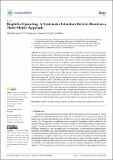| dc.contributor.author | Lefosse, Deborah | |
| dc.contributor.author | van Timmeren, Arjan | |
| dc.contributor.author | Ratti, Carlo | |
| dc.date.accessioned | 2023-11-27T15:35:08Z | |
| dc.date.available | 2023-11-27T15:35:08Z | |
| dc.date.issued | 2023-11-07 | |
| dc.identifier.uri | https://hdl.handle.net/1721.1/153051 | |
| dc.description.abstract | In response to socio-ecological challenges, cities around the world are implementing greenification and urban forestry. While these strategies contribute to reducing the ecological footprint, they often overlook various social implications. This explains the increasing global attention to Biophilia, which emphasizes human–nature interaction to enhance the quality of urban life. Despite its historical roots spanning centuries, Biophilia is still considered an emerging research field, as shown by debate on evidence-based research and measurement of its multidimensional impacts. Although the beneficial effects of Biophilic Design (BD) are well documented thanks to the small-scale and immediate outcomes, the long-term potential of Biophilic Urbanism (BU) offers less evidence, limiting its utilization and investment. This paper provides a comprehensive theoretical-practical framework on Biophilia, BD, and BU through a 60-year systematic literature review based on a three-metric approach (quality, quantity, and application). Investigating concepts and practices, we delve into biophilic effects on humans and urban livability, analyze tools to measure them, and explore methods to translate them into the built environment. In spite of the growing body of studies and advancements in the last decade, our review findings highlight the need for further insights, especially regarding BU. The study aims to promote Biophilia Upscaling as a strategy to maximize its direct and indirect benefits across urban scales, thereby promoting BU and expediting a paradigm shift in city planning. In metropolises conceived as bioregional systems, where nature plays a key role in ensuring ecological services and citizens’ well-being, BU can assist designers, planners, and city makers in addressing the urban agenda toward higher environmental and social standards. | en_US |
| dc.publisher | Multidisciplinary Digital Publishing Institute | en_US |
| dc.relation.isversionof | http://dx.doi.org/10.3390/su152215702 | en_US |
| dc.rights | Creative Commons Attribution | en_US |
| dc.rights.uri | https://creativecommons.org/licenses/by/4.0/ | en_US |
| dc.source | Multidisciplinary Digital Publishing Institute | en_US |
| dc.title | Biophilia Upscaling: A Systematic Literature Review Based on a Three-Metric Approach | en_US |
| dc.type | Article | en_US |
| dc.identifier.citation | Sustainability 15 (22): 15702 (2023) | en_US |
| dc.contributor.department | Senseable City Laboratory | |
| dc.contributor.department | Massachusetts Institute of Technology. Department of Urban Studies and Planning | |
| dc.contributor.department | Massachusetts Institute of Technology. School of Architecture and Planning | |
| dc.identifier.mitlicense | PUBLISHER_CC | |
| dc.eprint.version | Final published version | en_US |
| dc.type.uri | http://purl.org/eprint/type/JournalArticle | en_US |
| eprint.status | http://purl.org/eprint/status/PeerReviewed | en_US |
| dc.date.updated | 2023-11-24T14:23:01Z | |
| dspace.date.submission | 2023-11-24T14:23:01Z | |
| mit.license | PUBLISHER_CC | |
| mit.metadata.status | Authority Work and Publication Information Needed | en_US |
